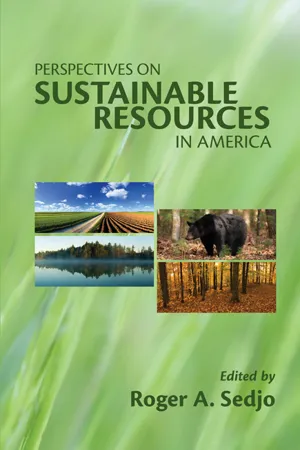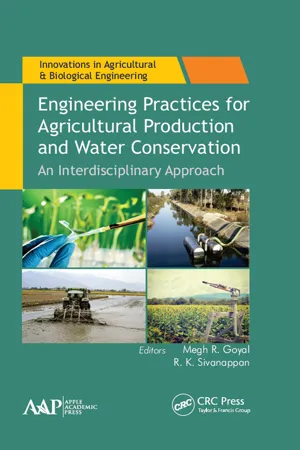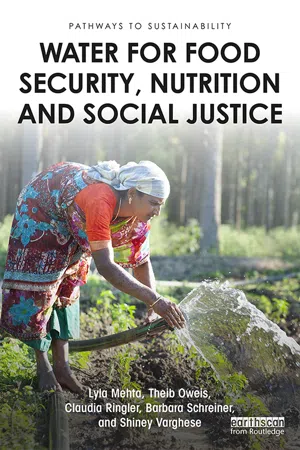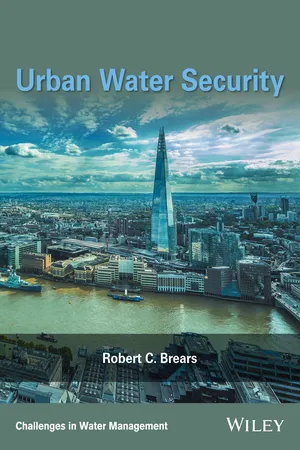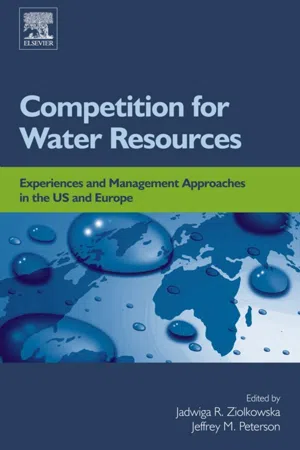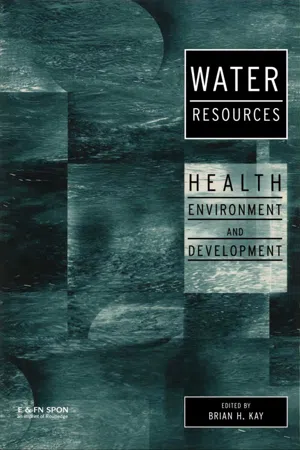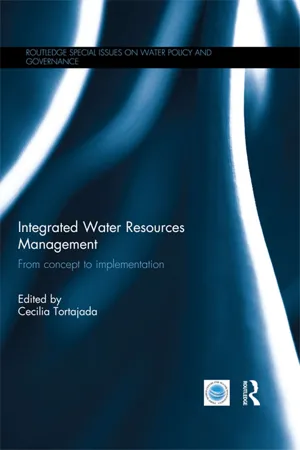Geography
Water Supply Management
Water supply management refers to the planning, development, and maintenance of systems for providing clean water to communities. It involves the sustainable use and distribution of water resources, as well as the implementation of policies and technologies to ensure reliable access to safe drinking water. Effective water supply management is crucial for supporting human health, economic development, and environmental sustainability.
Written by Perlego with AI-assistance
Related key terms
Related key terms
1 of 4
Related key terms
1 of 3
11 Key excerpts on "Water Supply Management"
- eBook - ePub
- Roger A. Professor Sedjo(Author)
- 2010(Publication Date)
- Routledge(Publisher)
CHAPTER 5
Water Resources Management andthe Challenge of Sustainability
Leonard Shabman
WATER IS NEEDED to produce things people value, whether for manufacturing automobiles, growing lettuce and strawberries, ensuring greener lawns and full swimming pools, or for automated dishwashing to save time and improve household sanitation.1 And water provides for more than material comforts. In art, music, and literature, water in the landscape is a symbol of pleasure and inspiration. Water is the focus of even the least wild places—Japanese gardens and Las Vegas hotel fountains. Rivers, lakes, and reservoirs behind dams are at the center of many recreation experiences. To secure all these uses of water, significant public and private investments have been made to control and manage the flows of water in rivers and lakes and into estuaries. Dams create reservoirs that store rainfall and snowmelt from wet times to provide water during dry times. Pipelines and canals move water over long distances. Wells are drilled and water is pumped to the surface and used in homes and on farms.Water availability and the adequacy of the nation's water supply infrastructure to serve those many uses is a long standing national concern (Select Committee 1961;Wollman and Bonem 1971; U.S. WRC 1978; U.S. GAO 1982). Recently, Congress requested a review of “the future of water availability for the nation [because] water is vital to the needs of growing communities, agriculture, energy production, and critical ecosystems” (USGS 2002; Barlow et al. 2004). The Executive Office of the President (Subcommittee on Water Availability and Quality 2004) and the U.S. Department of the Interior (2005) recently issued reports on future water availability. A report from the National Research Council (2001c, v) concludes,In this new century, the United States will be challenged to provide sufficient quantities of high-quality water to its growing population. Water is a limiting resource for human well-being and social development, and projections of population growth as well as changing social values suggest that demands for this resource will increase significantly. These projections have fueled concerns among the public and water resources professionals alike about the adequacy of future water supplies, the sustainability and restoration of aquatic ecosystems, and the viability of our current water resource research programs and our institutional and physical water resource infrastructures. - eBook - ePub
Engineering Practices for Agricultural Production and Water Conservation
An Interdisciplinary Approach
- Megh R. Goyal, R. K. Sivanappan(Authors)
- 2017(Publication Date)
- Apple Academic Press(Publisher)
Water is essential for life and used in many different ways. It is also a part of the large eco system on which the production of biodiversity depends. Fresh water scarcity is not limited to the arid regions only; in areas with good supply, access to safe water is becoming a critical problem. Lack of water is caused by low water storage capacity, low infiltration, large inter annual and annual fluctuations of precipitation due to monsoon rains and high evaporation demand.Rain water harvesting is as old as civilization and has been practiced continuously in different ways for different purposes in the world. None-theless, it has not been systematically in all places. A need has come to harvest rain water including roof water, to solve water problems everywhere, not only in arid but also in humid regions.1.2 AGRICULTURAL WATER MANAGEMENT
Agricultural water management may be defined as a skill of coordination of water resource, tapping, receipt, storage, conveyance, diversion, delivery, distribution and application constituent with the soil capability and the crop requirements for maximizing irrigation efficiency and economic returns. This definition implies resource inventory, system analysis, decision making and project evaluation. Hence, the scope of water management depends on the inter-relationships among variety of factors including irrigation practices, land use and cropping pattern individual and collection system of irrigation and overall economics. The definition of water management incorporates the critical role of risk factor, a new dimension which is well defined in other business disciplines, but not in agriculture. This dimension has a direct impact on nation’s economy. The risk factor associated with farm irrigation management is largely due to the erratic behavior of monsoon, the imbalance created in the supply – demand structure of agricultural commodities and the consequential variations in the marketing price, Government price fixation policy and the overall stress the farmer being subjected to by factors other than agriculture. - eBook - ePub
People and Environment
A Global Approach
- Gareth Jones(Author)
- 2014(Publication Date)
- Routledge(Publisher)
5 Environmental (mis)management of fresh water Water is the sovereign wealth of a state and its people. It is nourishment; it is fertilizer; it is power; it is transport. Brunhes, 1920 Mismanagement of water has occurred almost since humans became settled agriculturalists and water management policies became focused on short-term solutions and not long-term sustainable solutions. This chapter examines how, in spite of the abundance of water on Earth, we have mis-treated a free resource, resulting in water shortages and a lowering of the quality of supply. A number of case studies are used to show how management of water is central to the economy of a region. The chapter ends by examining a strategy for sustainable water management. 5.1 Introduction How unfortunate that the quotation from Brunhes (1920) with which this chapter opens has been all but forgotten by society over the years since it was written. The ways in which we have mismanaged our fresh water supplies has led to the current predicament of increasing shortages, a lowering of quality and an increase in cost of fresh water that is occurring throughout the world. In the past, society neglected the value of their water supply at their peril and the once great civilization of Mesopotamia that flourished circa 4000 BC (Sears, 1972: 132) and the Inca civilization between AD 1440–1534 (Chepstow-Lusty et al., 1998) are thought to have failed because the agricultural systems fell into decline due to a breakdown in the irrigation system. The early failures to manage the water supply were, undoubtedly, disastrous for the relatively small numbers of people dependent on them. By comparison, the implications of the current challenge to provide a sustainable, safe water supply is several magnitudes greater and is of concern to approximately two-thirds of the world population – some four billion people living in almost every part of the world - eBook - ePub
Urban Water Crisis and Management
Strategies for Sustainable Development
- Sughosh Madhav, Abhishek Kumar Bhardwaj, Eugenia Valsami-Jones, Arun Lal Srivastav(Authors)
- 2022(Publication Date)
- Elsevier(Publisher)
Undoubtedly, the reasons behind the delivery of polluted water and increase in the cost of distributing water are also very important. Each of these issues indicates that understanding urban water supply, design, and management must be an essential section of urban planning. Similarly, land use choices influence supply and distribution of water, designs as well as setup of wastewater systems, and management of stormwater runoff (Al-Zahrani and Moied, 2001). Therefore, there is a crucial necessity for integration of both conventional and modern science and technology to empower eco-friendly, sustainable, and cost-effective management, maintenance, and treatment of supply. This integrated approach must also guide the planning, design, and construction of the supply system for preservation, protection, and conservation of community health and enhancement of water quality (VanBriesen et al., 2014). 2: Sources of water availability and water demand The sources of water also play a vital part in regard to evaluating the sustainability of a water supply system. Water supply systems that are reliant on long-distance transportation of water from outlying sources incur additional costs and energy use, and the lengthy constructed distribution infrastructure is very unstable and needs much maintenance. However, an eco-friendly community where the entire water supply system is reliant on rainwater collection and harvesting by individual houses is highly sustainable regarding the source of water, at least primarily for a region with dependable annual precipitation amounts. Both surface water and groundwater are significant resources for public water supply demands. Groundwater is the conventional source for single houses and small towns, whereas reservoirs, lakes, and rivers are typical sources for megacities - Lyla Mehta, Theib Oweis, Claudia Ringler, Barbara Schreiner, Shiney Varghese(Authors)
- 2019(Publication Date)
- Routledge(Publisher)
The boundaries of these irrigated fields, systems, watersheds and river basins, generally differ from political or administrative boundaries. This introduces significant challenges in aligning agricultural water management with other sectors, such as energy or urban spaces, which typically operate according to the political or administrative boundaries. This section outlines some of the critical aspects of water management at various scales, and their implications for FSN. Global level Many processes at the global scale are relevant to water use in agriculture, such as trade in food and other commodities as well as global policies and international agreements on climate, energy, finance and development (see Chapter 5). Other international processes matter as well, such as on investment, sustainable development, and importantly, on the environment. Of particular importance has been the adoption of the Sustainable Development Goals in 2015, with a separate Goal on Water and Sanitation titled ‘Ensure availability and sustainable management of water and sanitation for all’. While this is an important improvement over the Millennium Development Goals that only referred to drinking water and were limited to countries in the global South, SDG 6 is on Water and Sanitation, and is global in nature. Still, this too does not refer to water use in agriculture, despite its overwhelming role in freshwater use. On the positive side, in January 2017, 83 ministers of agriculture accounting for most agricultural water use globally, jointly declared that they ‘will work to ensure that agriculture shoulders its share of responsibility in achieving and maintaining good status of water bodies, including water quality and quantity’ and ‘acknowledge the need to take conservation, protection and sustainable use and management of water into account in agricultural and related policies’- eBook - ePub
- Robert C. Brears(Author)
- 2017(Publication Date)
- Wiley(Publisher)
Women play a central part in the provision, management and safeguarding of water: Despite women playing a key role in the collection and safeguarding of water for domestic purposes and agricultural use, women in most countries play minimal roles in the development and management of water resources. Therefore, policies are required to address women’s needs and empower women to participate in the decision-making and implementation process of water resources management.- Water has an economic value in all its competing uses and should be recognised as an economic good: It is vital to recognise the basic right of all humans to have access to clean water and sanitation at an affordable price. However, by managing water as an economic good, it is an important way of achieving efficient and equitable use of the resource while encouraging conservation and protection of water resources.
3.3.3 Benefits of managing water in an integrated mannerAccording to the Dublin Statement, there are significant benefits from managing water in an integrated way. For developing countries, in particular, effective water management will alleviate poverty and disease through increased food production, clean water and sanitation. In both developing and developed countries, there will be greater protection against natural disasters as higher quality data for water resources management enables countries to better manage droughts and floods. Regarding water conservation and sustainable urban development, effective water resources management will lead to increased water conservation and reductions in discharges of municipal and industrial wastes. This can be achieved through the enactment of appropriate water charges and discharge guidelines. In rural communities, the application of water-saving technology and improved management methods will result in increased agricultural production and rural water supply. At the same time, a more integrated approach to water resources management will protect fragile aquatic ecosystems through decreased disruption of waterways and lower levels of pollution.89 - eBook - ePub
Competition for Water Resources
Experiences and Management Approaches in the US and Europe
- Jadwiga R Ziolkowska, Jeffrey M Peterson(Authors)
- 2016(Publication Date)
- Elsevier(Publisher)
Part 4The Future of Water
Prospects and Challenges for Water Management in the 21st Century
A. Tarhule The University of Oklahoma, Norman, OK, United StatesAbstract
Water is the driver of nature and its availability and quality often constitute a limit on economic development and human welfare. Because of this primacy, the task of providing water in sufficient quantity and acceptable quality to the world's human population while assuring its availability for future needs constitutes one of the preeminent challenges of the 21st century. As the chapters in this book show, the challenges are numerous and widely cited. Globally, around 750 million people, most living in developing countries, lack access to safe drinking water, 2.5 billion lack adequate sanitation, and 842,000 people still die annually because of diarrhea from contaminated water sources [World Health Organization/UNICEF Joint Monitoring Program (WHO/JMP), 2015]. These challenges are real and tragic, and ongoing efforts, such as the Strategic Development Goals of the United Nations Development Program, must be sustained until they are resolved.This chapter examines three questions likely to confront future water resources management, namely: Should water resources managers attempt to satisfy demand for water or curtail it? What is the economic status and value of water? What is the risk of future megadroughts caused by climate change?Question one is addressed by reviewing the changing paradigms in water resources management, especially the emerging concept of water soft path. To address question two, we examine the contested economic proposition of the uniqueness of water. Finally, question three is reviewed through the risk of future megadroughts as well as the real life experiment of the current California drought. These questions are illustrative of both the scope and complexity of future water resources challenges. - eBook - ePub
Water Resources
Health, Environment and Development
- Brian Kay(Author)
- 1998(Publication Date)
- CRC Press(Publisher)
Chapter 4Water resources development: policy perspectives of the Food and Agricultural Organization in relation to food security
Arumugam Kandiah
4.1 Introduction
Water sustains life; it is indispensable for the welfare of human beings and their natural environment. But scarcity and misuse of this life-supporting resource pose a serious and growing threat to food security, human health and well-being, industrial development and the ecosystems on which they depend. Scarcity or poor quality can have a dramatic impact not only on agricultural production, but on all aspects of everyday life, very often adding to the burden of women. There is an urgent need for judicious management of water resources worldwide.The world has witnessed the benefits and disadvantages of, respectively, the wise use and misuse of water as well as the hazards posed to natural resources, human health and environment by improper water resources developments based on inappropriate water policies. The Food and Agriculture Organization (FAO) believes that in order to overcome current deficiencies and to meet the total water needs of the human population, the management of water resources must form part of the spectrum of development endeavour. This approach offers the prospect of sustainable use of available water supplies as well as cost-effective solutions to present-day water problems. A wider understanding among different users, where each attaches a different value to it, that misuse by one group can adversely affect the others would be a major step towards achieving effective water management and harmony.4.2 The hydrological cycle
Fresh water is a renewable resource by virtue of the hydrological cycle, but for all practical purposes it is a finite one. The hydrological cycle is a continuous process by which water is transported from the oceans to the atmosphere to the land and back to the sea. Every year solar energy converts 500,000 km3 of water from sea and land into water vapour, which eventually returns to the earth’s surface as rain and snow (Figure 4.1 - eBook - ePub
Integrated Water Resources Management
From concept to implementation
- Cecilia Tortajada(Author)
- 2017(Publication Date)
- Routledge(Publisher)
Nevertheless, water is not the only sector that has these properties. In fact, innumerable other sectors cross-cut and overlap with other sectors and have both vertical and horizontal integration needs. Integrated approaches are very important within these sectors, too, and they have thus developed their specific approaches to systematize and promote integrated management. Examples include the health, natural resources management and coastal zone management sectors and their respective integrative approaches: health in all policies; integrated natural resources management; and integrated coastal zone management (Keskinen, 2010; Stucki, 2011).Various agencies and scholars have presented definitions of IWRM. One of the most commonly used is from the Global Water Partnership (GWP, 2000), for whom IWRM is:a process which promotes the coordinated development and management of water, land and related resources in order to maximise economic and social welfare in an equitable manner without compromising the sustainability of vital ecosystems and the environment.The World Water Council (2000) define it as aphilosophy that holds that water must be viewed from a holistic perspective, both in its natural state and in balancing competing demands on it – agricultural, industrial and environmental. Management of water resources and services need to reflect the interaction between these different demands, and so must be coordinated within and across sectors. If the many crosscutting requirements are met, and if there can be horizontal and vertical integration within the management framework for water resources and services, a more equitable, efficient, and sustainable regime will emerge.Accordingly, waters should be used to provide economic well-being to people, without compromising social equity or environmental sustainability. This should happen in a basin-wide context, with stakeholder participation and under the prevalence of good governance (Keskinen, 2010; Varis & Keskinen, 2006; Varis, Keskinen, & Kummu, 2008; Figure 1). In this way, IWRM can be seen to aim at enhancing good governance and promoting balanced development in relation to social equity, economic growth and environmental sustainability (largely according to the philosophy of sustainable development, which is commonly defined through the triple bottom line as social, economic and environmental sustainability). While all these objectives are naturally very relevant and important, achieving such a balance is typically challenging due to the inherently political nature of decision and planning processes. The political nature is naturally connected to the feature that the three E’ - eBook - ePub
Sustainable Solutions for Water Resources
Policies, Planning, Design, and Implementation
- James L. Sipes(Author)
- 2010(Publication Date)
- Wiley(Publisher)
Comprehensive water conservation planning has the potential to improve water quality and instream flow levels, decrease the need for new capital investments, reduce vulnerability to drought, and protect valuable cultural and natural resources. Water conservation will continue to play a vitally important role in sustaining the water supply in the Southeast, as it is one of the most efficient and least expensive ways to protect water resources. Conservation measures do have an impact. In Sarasota County, Florida, for example, the per-capita water use has been reduced from 158 gallons to about 96 gallons per day simply by the community conservation efforts (Angelo, Hamann, and Klein, 2008).Integrating watershed planning with economic development master planning builds efficiencies and effectiveness in both processes and ensures compatibility among activities that might have competing objectives. The watershed planning process is intended to be iterative, holistic, geographically defined, integrated, and collaborative (EPA, 2008). (See Figure 3.10 .)Watershed protection management practices fall under four categories (EPA, 2008):1. Focus on drainage protection. Includes descriptions and applications of zoning techniques that can be used to limit development density or redirect density to less environmentally sensitive areas. 2. Establishment and protection of stream buffers. Describes important steps for protecting or establishing riparian buffer zones to enhance water quality and pollutant removal. 3. Emphasis on NPS contributions. Involves identifying potential upstream sources of nonpoint source pollution as well as providing solutions to minimize those impacts.4. Identify and preserve critical areas. Entails identifying properties that if preserved or enhanced could maintain or improve water quality and reduce the impacts of urban runoff as well as preserving environmentally significant areas (includes land acquisition, easements, and development restrictions of various types).A watershed-based planning approach can help communities make better decisions on watershed restoration priorities and make the most out of limited funding and staffing resources. Many communities are proving they can extend their existing water supplies simply by encouraging water efficiency. Cary (NC) reduced its water consumption by 15% in 11 years, and Tampa Bay (FL), with a population of over 2.5 million, reduced its consumption by 26% over 12 years (Wodder, 2008). - Alan Terry, Jennifer Hill(Authors)
- 2016(Publication Date)
- Routledge(Publisher)
This awareness, together with Tunisia’s obligations to the Rio Convention and Agenda 21, was reflected in the commissioning of two surveys of water resources and demand in 1995 and 2000 (Eau 2000 and Eau XXI). These studies culminated in a comprehensive Water Sector Review (Etude sur le Secteur de l’Eau) upon which the government’s current sustainable water programme (Strategie de Gestion de l’Eau) is based. It plans for the mobilization, exploitation and improved quality of water resources by 2030 and builds upon Tunisia’s expertise in the fields of water resource mobilization and integrated management in a context of aridity, water scarcity and social and economic restraints (Vidal, 2001). An increasingly significant outcome of the programme is the re-introduction of local water management using indigenous techniques. In its national report to the Rio +10 conference in Johannesburg in 2002, Tunisia outlined its progress in sustainable water management (Ministry of Environment and Land Use Planning, 2001) and emphasized its integrated approach which takes into account economic, social, institutional and ecological considerations. Local management ‘which is governed by consultations and negotiation’ together with ‘active participation of responsible partners in decision-making’ was encouraged ‘to ensure water sustainability through rational utilization’ (Ministry of Environment and Land Use Planning, 2001: 58). Whether this is rhetoric or reality may be appraised by a study of water management techniques across Tunisia, and it forms the subject of this chapter. Two case studies are used to describe contrasting water management techniques: traditional small-scale rainwater harvesting and modern large-scale dam irrigation 1. Sustainability is examined using a human ecological approach, which addresses the interlocking nature of society and environment using ideas and methods of geography, ecology and anthropology (Simmons, 1997; Marten, 2001)
Index pages curate the most relevant extracts from our library of academic textbooks. They’ve been created using an in-house natural language model (NLM), each adding context and meaning to key research topics.
Explore more topic indexes
Explore more topic indexes
1 of 6
Explore more topic indexes
1 of 4
